Weltkriegschaft
- Thread starter TheHyphenated1
- Start date
-
We have updated our Community Code of Conduct. Please read through the new rules for the forum that are an integral part of Paradox Interactive’s User Agreement.
You are using an out of date browser. It may not display this or other websites correctly.
You should upgrade or use an alternative browser.
You should upgrade or use an alternative browser.
Narrowly eh? I guess Al Landon putted up a tougher fight this time around than OTL
Kurt_Steiner - Just imagine the influence he would have had on the war OTL if he had been helping the Allies' cause. Oh, wait...
Slaughts - Yes indeed. See the note attached to the bonus picture.
Bonus picture: Alf Landon on the cover of Time before the election. During the Republican primaries, Frank Knox and William Edgar Borah had a well-publicized exchange about the situation in Europe. Knox spoke prophetically at the end of March, stating that he: "Would not be surprised if within a year World War is again upon us." Less than two weeks later, war had erupted. Worried about Knox's surging popularity, Borah famously denied that the conflict in Europe had become a world war. Knox found himself the standard bearer of the vocal minority of Americans who advocated alignment with Britain. With Borah effectively out of the race, it became a two-way contest between Landon and Knox. Landon narrowly secured the nomination, but Knox was for a time the greater celebrity. With Knox as his running mate, Landon hammered Roosevelt on his purported isolationism in the general election, winning some 45 percent of the popular vote. Nonetheless, a majority of Americans were convinced that pulling the country out of the Depression was more important than getting tangled in a war which many viewed as having been started by the Allies. Republicans were forced to pin their hopes on 1940.
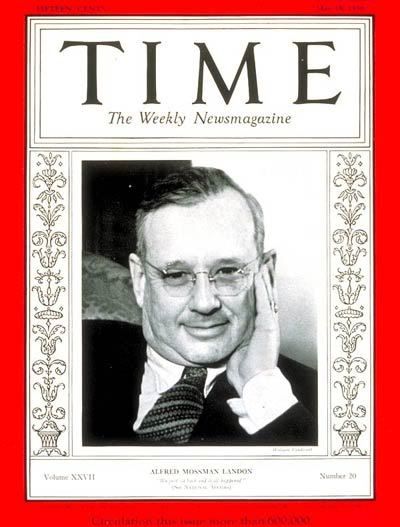
Slaughts - Yes indeed. See the note attached to the bonus picture.
Bonus picture: Alf Landon on the cover of Time before the election. During the Republican primaries, Frank Knox and William Edgar Borah had a well-publicized exchange about the situation in Europe. Knox spoke prophetically at the end of March, stating that he: "Would not be surprised if within a year World War is again upon us." Less than two weeks later, war had erupted. Worried about Knox's surging popularity, Borah famously denied that the conflict in Europe had become a world war. Knox found himself the standard bearer of the vocal minority of Americans who advocated alignment with Britain. With Borah effectively out of the race, it became a two-way contest between Landon and Knox. Landon narrowly secured the nomination, but Knox was for a time the greater celebrity. With Knox as his running mate, Landon hammered Roosevelt on his purported isolationism in the general election, winning some 45 percent of the popular vote. Nonetheless, a majority of Americans were convinced that pulling the country out of the Depression was more important than getting tangled in a war which many viewed as having been started by the Allies. Republicans were forced to pin their hopes on 1940.

Last edited:
The next installment of our story, III:XXIX, will require an unusual amount of research (and a rare book or two) to get right. While I go about this work, which I anticipate may delay our story somewhat, I plan to provide some sort of bonus material to keep y'all interested.
What would you like to see in this regard? Contests? Background information? More photos? Something else? I'm eager to hear what would be most interesting to you.
Now's your chance to weigh in!
What would you like to see in this regard? Contests? Background information? More photos? Something else? I'm eager to hear what would be most interesting to you.
Now's your chance to weigh in!
I call background Information.
Me too, if it's not too much asking.
The schemes and maneuverings of the intelligence services are always fun to read about. Good update.
Looks like background information it is. What would you guys like to hear about?
Hardraade - Thanks very much!
dublish - He is currently Chiang Kai Shek's foremost general. He's in Nanjing right now, and Asia is fairly quiet. Unfortunately not really much more to report on Zhang at the moment.
Slaughts - Weapons information is next.
dublish - He is currently Chiang Kai Shek's foremost general. He's in Nanjing right now, and Asia is fairly quiet. Unfortunately not really much more to report on Zhang at the moment.
Slaughts - Weapons information is next.
Hardraade - Thanks very much!
dublish - He is currently Chiang Kai Shek's foremost general. He's in Nanjing right now, and Asia is fairly quiet. Unfortunately not really much more to report on Zhang at the moment.
Slaughts - Weapons information is next.
Yay!!
Note: This is not an update. Just a special bonus feature. Hence the brevity.
And now, the first in our little mini-series on weapons development:
The Panzerwaffe
Although Generalleutnant Paul Hausser’s panzers performed extremely well in France, HKK attributed that mainly to superior communications and organization. Further, because the Maginot Line had been totally flanked, the Panzerwaffe was attacking through country altogether unprepared to face armored assault. Wherever the PzKpfw I encountered the heavier French tanks, such as the AMR 35 and Char D1, it was totally outclassed.
Indeed as early as May, the General Staff had identified the Panzer I’s light armament as a potentially ruinous strategic weakness. Without the capability to knock out enemy tanks on its own, it could not operate ahead of infantry for any length of time, rendering its speed almost meaningless. And so, urgent orders were placed for tanks that could compete with their Allied counterparts.
The Panzer II was already seen as obsolete, and so attempts were made to hurry production of the newer Panzer IIIs and Panzer IVs. As late as 1935, however, the War Ministry had not envisioned the war starting until some around 1941. As a result, when war broke out in April of 1936, Germany’s production capacity for these tanks was pitifully inadequate. In particular, manufacturers struggled to produce the specialized bearings, gun mounts and engine parts required for these heavier tanks. The Panzer IV, produced as the PzKpfw IV Ausf. A from July, also suffered problems with its main gun. The Kampfwagenkanone 37 L/24 was difficult to manufacture to the exacting standards of quality required, and production had been repeatedly moved around Germany over the early summer. Nonetheless, on July 6, the first operational Panzer IV rolled off the production line at Krupp-Grusonwerke AG in Magdeburg.
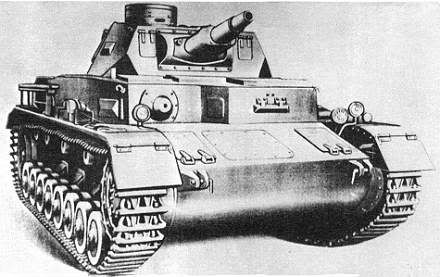
Problems persisted though, as the first machine wrecked its engine in trials, revealing a flaw in the dies used in mass production. By November 7, only 9 working Panzer IVs have been produced, with no sign of an impending increase in production.
Nonetheless, HKK has slated 5 of these 9 tanks for conversion into “dive-tanks” along with some of the also-scarce Panzer IIIs. It is hoped that such vehicles could be of use in amphibious operations, but so far, the project has had little success.
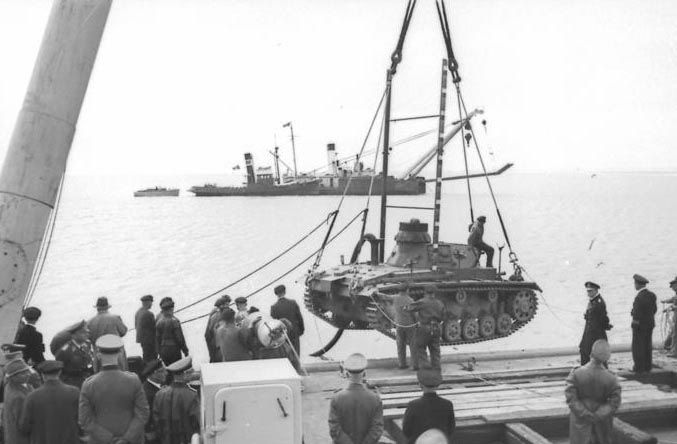
It remains to be seen how successful the Panzer I will be when no longer operating in the wide open spaces of Picardy.
Up next: The Luftwaffe!
And now, the first in our little mini-series on weapons development:
The Panzerwaffe
Although Generalleutnant Paul Hausser’s panzers performed extremely well in France, HKK attributed that mainly to superior communications and organization. Further, because the Maginot Line had been totally flanked, the Panzerwaffe was attacking through country altogether unprepared to face armored assault. Wherever the PzKpfw I encountered the heavier French tanks, such as the AMR 35 and Char D1, it was totally outclassed.
Indeed as early as May, the General Staff had identified the Panzer I’s light armament as a potentially ruinous strategic weakness. Without the capability to knock out enemy tanks on its own, it could not operate ahead of infantry for any length of time, rendering its speed almost meaningless. And so, urgent orders were placed for tanks that could compete with their Allied counterparts.
The Panzer II was already seen as obsolete, and so attempts were made to hurry production of the newer Panzer IIIs and Panzer IVs. As late as 1935, however, the War Ministry had not envisioned the war starting until some around 1941. As a result, when war broke out in April of 1936, Germany’s production capacity for these tanks was pitifully inadequate. In particular, manufacturers struggled to produce the specialized bearings, gun mounts and engine parts required for these heavier tanks. The Panzer IV, produced as the PzKpfw IV Ausf. A from July, also suffered problems with its main gun. The Kampfwagenkanone 37 L/24 was difficult to manufacture to the exacting standards of quality required, and production had been repeatedly moved around Germany over the early summer. Nonetheless, on July 6, the first operational Panzer IV rolled off the production line at Krupp-Grusonwerke AG in Magdeburg.

Problems persisted though, as the first machine wrecked its engine in trials, revealing a flaw in the dies used in mass production. By November 7, only 9 working Panzer IVs have been produced, with no sign of an impending increase in production.
Nonetheless, HKK has slated 5 of these 9 tanks for conversion into “dive-tanks” along with some of the also-scarce Panzer IIIs. It is hoped that such vehicles could be of use in amphibious operations, but so far, the project has had little success.

It remains to be seen how successful the Panzer I will be when no longer operating in the wide open spaces of Picardy.
Up next: The Luftwaffe!
Last edited:
If I only had nine tanks, I probably wouldn't try to find out what happens when I stick half of them underwater...
If I only had nine tanks, I probably wouldn't try to find out what happens when I stick half of them underwater...
Well, you could try what the Allies did and just stick half of a single tank underwater...

If it sees its shadow when it comes up, that means six more weeks of German occupation.
Note: Not an update. Just a little bonus feature. Hence the brevity.
Installment two of our little bonus series on weapons development. Let me know what else you may be interested in!
The Luftwaffe
Fighters
The Luftwaffe has become acutely aware of the need for a fully modern, monoplane fighter. It is known that the British are developing a powerful new fighter of their own, designed by Hawker and having first flown some time in late 1935. It is feared that this new aircraft could see combat before its German counterpart, and possibly significantly reverse the gains made by the Luftwaffe in the skies over Britain. The German answer to this new British threat is the Messerschmitt Bf 109.

The prototype Bf 109 V3 was Bavarian Aircraft Works’ answer to the contest for a new fighter put out by the Reich Air Ministry two years before. Following a difficult development history, the V3 at last flew on June 19 at the Luftwaffe test center at Rechlin in Pomerania.
For the first two weeks in August, Messerschmitt’s V3 went head-to-head at Travemünde against rival aircraft manufacturers' entries in the design contest: Focke-Wulf’s Fw 159, Arado’s Ar 80 and Heinkel’s He 112. Although test pilots initially found the much more “aggressive” flight characteristics of the Bf 109 disconcerting, it was soon considered clearly the best design. Despite some resistance from Milch and Göring, HKK approved the contract, and preparations were immediately made to begin production as soon as possible. Estimates currently project significant combat deployment by early summer of 1937.
Bombers
The most promising medium bomber, according to present HKK project evaluations, is the Junkers Ju-88. Flying first on November 2 near Dessau, the prototype Ju-88 had a range of 2,000 kilometers. Attaining an airspeed of nearly 580 kilometers per hour, the design was very pleasing to both General Göring and General Wever.
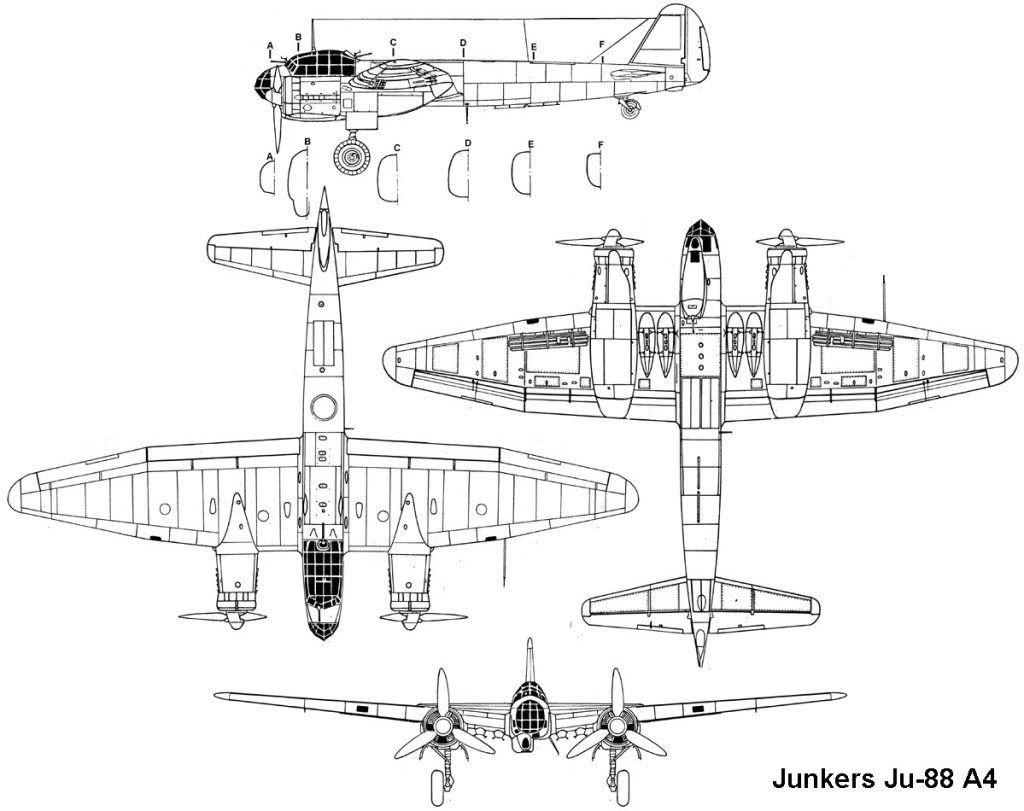
Both men raised the possibility of such a fast, powerful bomber being used as a decisive weapon against Britain in the event that Operation Löwengrube either failed or was aborted. With this in mind, HKK ordered design features favorable to the anti-shipping role incorporated into later prototypes. In truth, though, many doubted the wisdom of designing the Ju-88 based on the current strategic situation, as even optimistic estimates placed the Ju-88 in service no earlier than mid to late 1938.
Dive Bombers
The Junkers Ju-87, for its part, was farther along in development. This accurate and hardy dive-bomber was already being flown by the training cadre of Sturzkampfgeschwader 51, the Luftwaffe’s elite new dive-bombing squadron. It was hoped that it could see service in time for Löwengrube, in the hope that modern air power could play a decisive role in neutralizing the Royal Navy. A number of pilots from the LDvB had been recalled from the Mediterranean to advise the Ju-87’s design team on optimizations for the aircraft, based on their experience hunting British shipping.
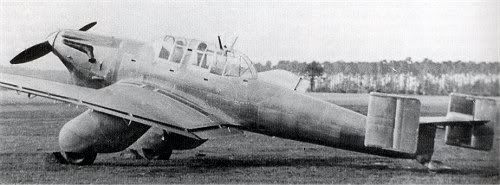
The Nationalists in Spain had appealed persistently and desperately to the Pact for military assistance, knowing that air support from the modern planes of the Luftwaffe and Regia Aeronautica would help them to overcome the Republican forces. Locked in a desperate struggle against Britain, both Germany and Italy sent polite regrets but declined. Some in HKK had seen the Spanish Emergency as a useful proving ground for new tanks and aircraft, like the Ju-87, but it was plain that there was nothing to spare. Now, with the right-wing rebellion almost crushed by the Republicans, the point was nearly moot.
Up next: the U-bootwaffe
Installment two of our little bonus series on weapons development. Let me know what else you may be interested in!
The Luftwaffe
Fighters
The Luftwaffe has become acutely aware of the need for a fully modern, monoplane fighter. It is known that the British are developing a powerful new fighter of their own, designed by Hawker and having first flown some time in late 1935. It is feared that this new aircraft could see combat before its German counterpart, and possibly significantly reverse the gains made by the Luftwaffe in the skies over Britain. The German answer to this new British threat is the Messerschmitt Bf 109.

The prototype Bf 109 V3 was Bavarian Aircraft Works’ answer to the contest for a new fighter put out by the Reich Air Ministry two years before. Following a difficult development history, the V3 at last flew on June 19 at the Luftwaffe test center at Rechlin in Pomerania.
For the first two weeks in August, Messerschmitt’s V3 went head-to-head at Travemünde against rival aircraft manufacturers' entries in the design contest: Focke-Wulf’s Fw 159, Arado’s Ar 80 and Heinkel’s He 112. Although test pilots initially found the much more “aggressive” flight characteristics of the Bf 109 disconcerting, it was soon considered clearly the best design. Despite some resistance from Milch and Göring, HKK approved the contract, and preparations were immediately made to begin production as soon as possible. Estimates currently project significant combat deployment by early summer of 1937.
Bombers
The most promising medium bomber, according to present HKK project evaluations, is the Junkers Ju-88. Flying first on November 2 near Dessau, the prototype Ju-88 had a range of 2,000 kilometers. Attaining an airspeed of nearly 580 kilometers per hour, the design was very pleasing to both General Göring and General Wever.

Both men raised the possibility of such a fast, powerful bomber being used as a decisive weapon against Britain in the event that Operation Löwengrube either failed or was aborted. With this in mind, HKK ordered design features favorable to the anti-shipping role incorporated into later prototypes. In truth, though, many doubted the wisdom of designing the Ju-88 based on the current strategic situation, as even optimistic estimates placed the Ju-88 in service no earlier than mid to late 1938.
Dive Bombers
The Junkers Ju-87, for its part, was farther along in development. This accurate and hardy dive-bomber was already being flown by the training cadre of Sturzkampfgeschwader 51, the Luftwaffe’s elite new dive-bombing squadron. It was hoped that it could see service in time for Löwengrube, in the hope that modern air power could play a decisive role in neutralizing the Royal Navy. A number of pilots from the LDvB had been recalled from the Mediterranean to advise the Ju-87’s design team on optimizations for the aircraft, based on their experience hunting British shipping.

The Nationalists in Spain had appealed persistently and desperately to the Pact for military assistance, knowing that air support from the modern planes of the Luftwaffe and Regia Aeronautica would help them to overcome the Republican forces. Locked in a desperate struggle against Britain, both Germany and Italy sent polite regrets but declined. Some in HKK had seen the Spanish Emergency as a useful proving ground for new tanks and aircraft, like the Ju-87, but it was plain that there was nothing to spare. Now, with the right-wing rebellion almost crushed by the Republicans, the point was nearly moot.
Up next: the U-bootwaffe
Last edited:

